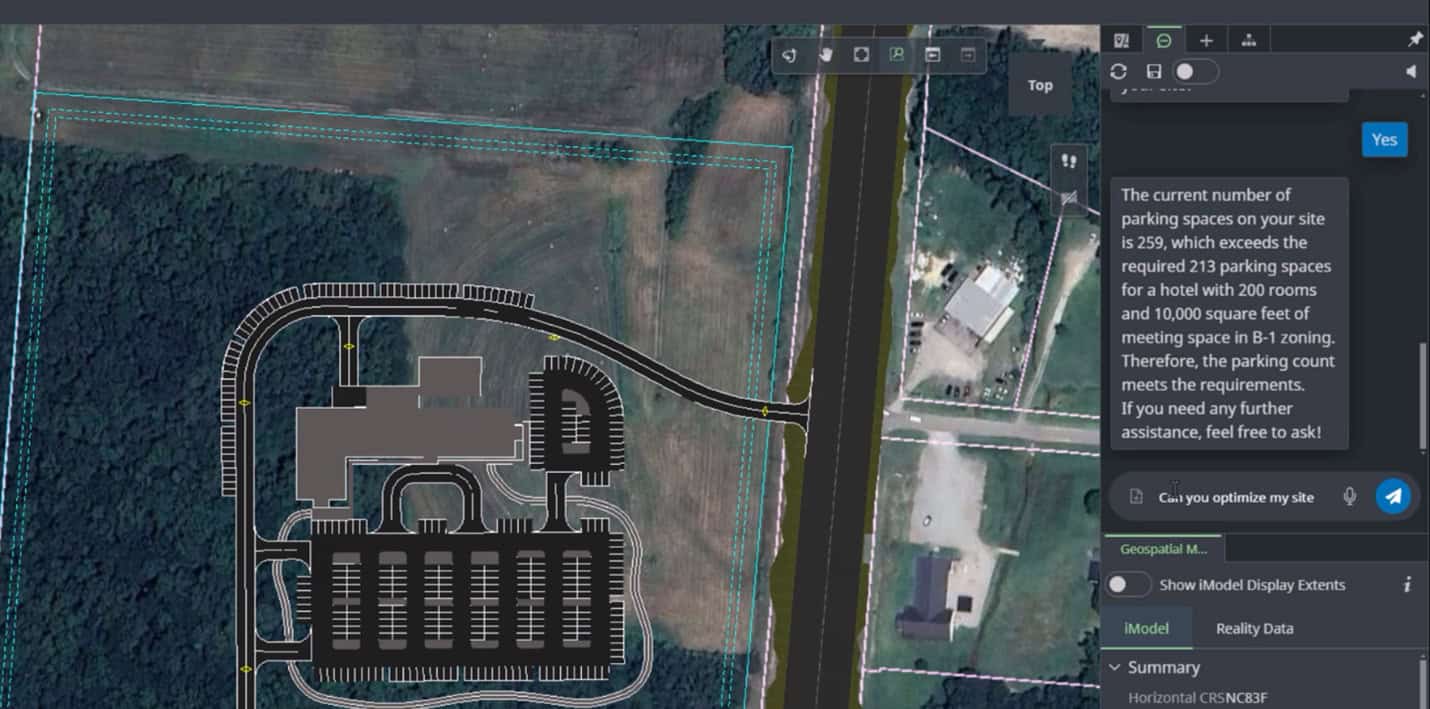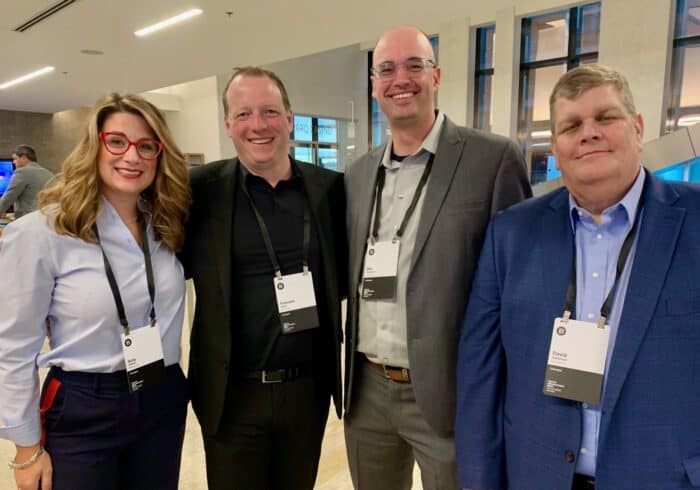Joe Viscuso always chased the next big thing. “Growing up, I just wanted to be the first to have it,” he says. “The new Ford Mustang, it didn’t matter what it was.”
That passion and curiosity have also propelled his career.
His latest obsession is generative AI and how it’s transforming his field — civil engineering and construction. Viscuso is responsible for strategic growth at Pennoni, the Philadelphia-based engineering and design consulting firm, and he has spent 15 years teaching land development as an adjunct professor at Pennsylvania’s Widener University. “Our goal here at Pennoni is to be at the forefront of the technology,” he says. In the age of AI, that pursuit has become a lot more urgent. “We used to measure change in decades. Now we measure it in weeks, days and minutes,” he says.
Viscuso and his team, and other civil engineering firms, have been advising Bentley Systems on the development of OpenSite+. The next-generation software uses generative AI to help civil engineers design land development sites for new industrial facilities, shopping centers, schools, parks or entire neighborhoods. Bentley Systems, the infrastructure engineering software company behind the new solution, says OpenSite+ creates site designs up to 10 times faster than traditional methods and with greater accuracy.
“We have been dreaming about building a product like this for decades, and it is finally happening,” says David Settlemyer, an expert in the field and senior product manager for civil engineering at Bentley. For example, one key feature is the software’s ability to “generate” so-called smart objects. These advanced digital components understand their context and can adapt to design changes. “We’re creating information, and that’s the big paradigm shift,” Settlemyer says “In OpenSite+, elements know what they are, down to the square inch, whether it’s a parking lot, building pad, driveway or storm drainage.”
The software comes equipped with an AI-driven Copilot, automated drawing production capabilities, and site layout and grading optimization tools that allow users to evaluate multiple design alternatives. Users can control the software with their voice and prompt it to edit footprints for buildings, parking layouts, driveways, sidewalks, ponds and other infrastructure. “I don’t ever want to be in a situation when one of our competitors is showing software like this to one of our clients and we didn’t know anything about it,” Viscuso says. With OpenSite+, “I’ll be able to attract more clients and grow the top line of the firm,” he says.
Digital painkiller
Laying out a site for a large project, like a new Walmart, is a laborious process that can take weeks. Bentley’s new software with generative AI can save users hours spent on mundane tasks, like laying out parking lots or creating drawings. This is a big plus for an industry that is facing a shortage of engineers. “We need housing, we need grocery stores, the world’s population is growing, but the number of site engineers we need to design these things is not growing at the same rate,” Settlemyer says. “A lot of site design engineering firms are turning down work because they can’t find people and just can’t physically get it done. That is their biggest pain.”
OpenSite+ is about “letting an engineer be an engineer, not a drafter,” Settlemyer says. “Their clients pay them for their creativity, being able to use their engineering acumen. With OpenSite+, we’re taking something that could take hours, and we’ve reduced it down to sometimes less than a minute. That’s big. These are huge savings.”
Get the balance right
The software can also help save tens of thousands of dollars by quickly generating and finding design options that minimize the need to move earth on and off construction sites. The process is called site balancing, and it’s a tricky problem.
In a perfect world, no trucks would be taking dirt on or off the construction site. “If a civil engineer could do that, they’d be the best civil engineer in the world,” Viscuso says. He says that if he assigned 15 students in his class to balance a Walmart site, “I am going to get back 15 different designs and not one would be right or wrong. They are all going to work, and the Walmart is going to open its doors. But each one of them would have a different impact on the cost to build it and the site grading.”
Viscuso says better balancing sites and eliminating all those truckloads of dirt is good for the budget – and for the environment. “If I had the ability to cut 400 trucks to 10, that’s a tremendous impact on sustainability,” he says. “Every one of those trucks is using diesel fuel and creating emissions. They are tearing up roads. There are environmental impacts we don’t even think about.”
A boost in the arm
 Bentley’s OpenSite+ software with copilot uses organization-specific documents and design models for quick insights and edits.
Bentley’s OpenSite+ software with copilot uses organization-specific documents and design models for quick insights and edits.The roots of OpenSite+ go back two decades to Charlotte, North Carolina. At the time, Settlemyer teamed up with AI pioneers Thomas Bäck and Ron Breukelaar to help a pair of local developers who were buying parcels in the Winston-Salem area and grew tired of getting the answers they needed well after they decided to invest in a property. They wanted software that would analyze a site and fetch them the insights they needed before they spent their money.
The software the team developed did more than that. Using AI, the software ran through millions of iterations and enabled users to estimate the cost of laying out a site based on factors like the amount of earth they need to move. It could also find an optimal way to prepare a construction site in minutes rather than days. “I never used the word AI back then because I think it scared people,” Settlemyer says.
 David Settlemyer, Ron Breukelaar, Francois Valois, and Amy Heffner (from right to left) were part of the Bentley team that developed OpenSite+.
David Settlemyer, Ron Breukelaar, Francois Valois, and Amy Heffner (from right to left) were part of the Bentley team that developed OpenSite+.Settlemyer joined a company called Blueridge Analytics and started offering the software to construction and engineering firms. The solution “didn’t remove the engineer’s ability to think as an engineer, to process data as an engineer, and make revisions as an engineer. We gave them tools to do it faster and better,” Settlemyer says. “We found them the cost, the amount of earth they’d be moving, or the amount of asphalt they’d need to bring. As an engineer, I can say, ‘All right, I like it,’ and if I don’t like it, then I can change the model.”
The software was called SiteOps and it started turning heads. It soon got the attention of Greg Bentley, former CEO of Bentley Systems, which acquired Blueridge Analytics and the rest is history.
A paradigm shift
Settlemyer and Breukelaar are now using new advances in generative AI to take their original idea to a new level. The technology allows them to create design suggestions within seconds by combining project and engineering data with information about the land from sources like the Cesium World Terrain and the U.S. Geological Survey, along with drainage data, building codes and regulations, and any number of other parameters. (Cesium, the 3D geospatial company, is now also part Bentley.)
Settlemyer’s favorite feature is the OpenSite+ Copilot, which allows users to talk to their software. “You can ask it questions like, ‘I want to change the angle of my parking spaces to 60 degrees instead of 90 degrees,’ or I can interrogate the model to see whether my parking lot meets the zoning code for that area,” he says.
The growth mindset
Viscuso, who opened his first engineering firm when he was just 29, is keen to bring OpenSite+ to his clients. A “top-line person” who likes to grow things, he believes that generative AI can revolutionize civil engineering, starting with site design. “When I first came into the business, we were hand drawing everything, literally pencil or ink on paper,” he says. “That basically is the same way that they did things from the time of the Egyptians.”
He says OpenSite+ is “the next generation to all the things we talked about, and it’s going to create the ability to do even more, better. It could even affect the cost of goods that Walmart has to charge for something, right? It’s a whole chain reaction.”
Says Viscuso: “I don’t ever like to use the word faster in our business; to me, it’s better. Better for the client, better for the environment, and better for the customer who eventually is going to come in and buy something at the store.”
North American site engineering firms can apply for early access to OpenSite+ here. For more information, please visit https://www.bentley.com/software/opensite-plus/.









